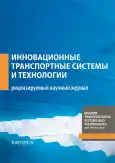Systematization of the application of polymer composite materials in the design of bridge structures
- 作者: Smerdov D.N.1
-
隶属关系:
- Siberian State Railway University
- 期: 卷 10, 编号 3 (2024)
- 页面: 419-434
- 栏目: Original studies
- URL: https://bakhtiniada.ru/transj/article/view/265912
- DOI: https://doi.org/10.17816/transsyst635339
- ID: 265912
如何引用文章
全文:
详细
Background. This study systematizes the principles of using polymer composite materials in bridge structure design, outlining the fundamental principles for calculating load-bearing structures of bridge spans featuring these materials.
Aim. The goal is to enhance the strength and durability of bridge spans during construction and maintenance, while optimizing costs through the use of polymer composite materials.
Materials and Methods. The research employs a modern approach to bridge structure design, utilizing mathematical statistics for experimental data analysis and numerical methods for calculating bridge structures using nonlinear deformation models of anisotropic materials.
Results. Developed principles for designing bridge spans with polymer composite elements include methods for strengthening and reinforcing concrete bridge structures. These methods account for operational factors such as long-term constant and temporary loads, low and elevated temperatures, as well as methods for designing all-composite spans pedestrian and road bridges
Conclusion. The principles of designing bridge spans with elements made of polymer composite materials have been introduced into the practice of transport construction in the Russian Federation. The technical and economic efficiency of using polymer composite materials in bridge structures of transport infrastructure has been confirmed.
作者简介
Dmitry Smerdov
Siberian State Railway University
编辑信件的主要联系方式.
Email: DNSmerdov@mail.ru
ORCID iD: 0000-0003-2022-4565
SPIN 代码: 7141-4210
Candidate of Sciences in Engineering, Senior Researcher
俄罗斯联邦, Novosibirsk参考
- Smerdov DN, Yashchuk MO. Experimental studies of the load-carrying capacity of flexible reinforced concrete elements strengthened by prestressed polymer composites. Russian Journal of Building Construction and Architecture. 2019;3(55):72–83. (In Russ.) doi: 10.25987/VSTU.2019.55.3.008
- Selivanova EO, Smerdov DN. Experimental study of creep in composite materials, bending reinforcement concrete elements. Akademicheskii vestnik UralNIIproekt RAASN. 2017;2(33):95–99. (In Russ.) EDN: ZAEKKP
- Nevolin DG, Smerdov MN, Smerdov DN. Experimental investigations of supporting capacity of reinforced-concrete constructions at mining-technical buildings and constructions. Izvestiya vysshikh uchebnykh zavedenii. Gornyi zhurnal. 2015;8:138–142. (In Russ.) EDN: VAYFKJ
- Klement’ev AO, Smerdov DN, Smerdov MN. Experimental studies of reliability and deformability of bending concrete elements reinforced in compression and tension areas by non-metallic composites. Transport Urala. 2014;4(43):50–55. (In Russ.) EDN: TFCSEB
- Bokarev SA, Kostenko AN, Smerdov DN, Nerovnykh AA. Experimental studies of reinforced with polymer composites ferroconcrete specimens at low and high temperatures. Internet-zhurnal ‘Naukovedenie’. 2013;3(16):168. (In Russ.) EDN: QZYAAT
- Bokarev SA, Smerdov DN. Experimental studies of bent reinforced concrete elements reinforced with composite materials. Automation in Construction. 2010;2(614):112–124. (In Russ.)
- Bokarev SA, Smerdov DN. Research of multiple freezing and thawing influence on change of bearing and deformative abilities of the reinforced concrete flexural elements strengthened by the composite materials. Transport Urala. 2010;3(26):98–104. (In Russ.) EDN: MVLIBL
- Bokarev SA, Ustinov VP, Yashnov AN, Smerdov DN. Usilenie proletnykh stroenii s ispol’zovaniem kompozitnykh materialov. Put’ i putevoe khozyaistvo. 2008;6:30–31. (In Russ.)
- Bokarev SA, Smerdov DN. Polymer composite materials in transport construction industry. Transport Urala. 2016;1(48):24–30. (In Russ.) EDN: VRDJSL doi: 10.20291/1815-9400-2016-1-24-30
- Bokarev SA, Smerdov DN, Nerovnykh AA. Metodika rascheta po prochnosti sechenii ekspluatiruemykh zhelezobetonnykh proletnykh stroenii, usilennykh kompozitnymi materialami. Izvestiya vysshikh uchebnykh zavedenii. Stroitel’stvo. 2010;10(622):63–74. (In Russ.)
- Bokarev SA, Smerdov DN. The nonlinear analysis of bending reinforced concrete structures strengthened by composite materials. Vestnik of Tomsk State University of Architecture and Building. 2010;2(27):113–125. (In Russ.) EDN: MNGZUN
- Smerdov DN, Klementyev AO. The calculation of the strength of the cross-sections normal to the longitudinal axis of bendable concrete elements with combined reinforcement in metal and polymer composite fittings, using a nonlinear deformation model of the material. Internet-zhurnal Naukovedenie. 2017;1(9):34. (In Russ.) EDN: YMXOVP
- Nevolin DG, Klementyev AO, Smerdov DN, Smerdov MN. A method to analyze performance of bendingconcrete elements reinforced with polymer composites. Transport Urala. 2015;3(46):98–101. (In Russ.) EDN: UKFQTT
- Plevkov VS, Baldin IV, Nevskii AV. Estimated Stresses in Steel and Carbon Reinforced Composite Rebar of Normal Sections in Concrete Structures. Vestnik of Tomsk State University of Architecture and Building. 2017;(1):96–113. (In Russ.) Accessed: 23.08.2024 Available from: https://vestnik.tsuab.ru/jour/article/view/273/274
- Ushakov AE, Klenin UG, Sorina TG, et al. Bridge structures made of composites. Composites and Nanostructures. 2009;(3):25–37. (In Russ.)]. Accessed: 23.08.2024 Available from: http://www.issp.ac.ru/journal/composites/2009/2009_3/ushakov.pdf
补充文件














